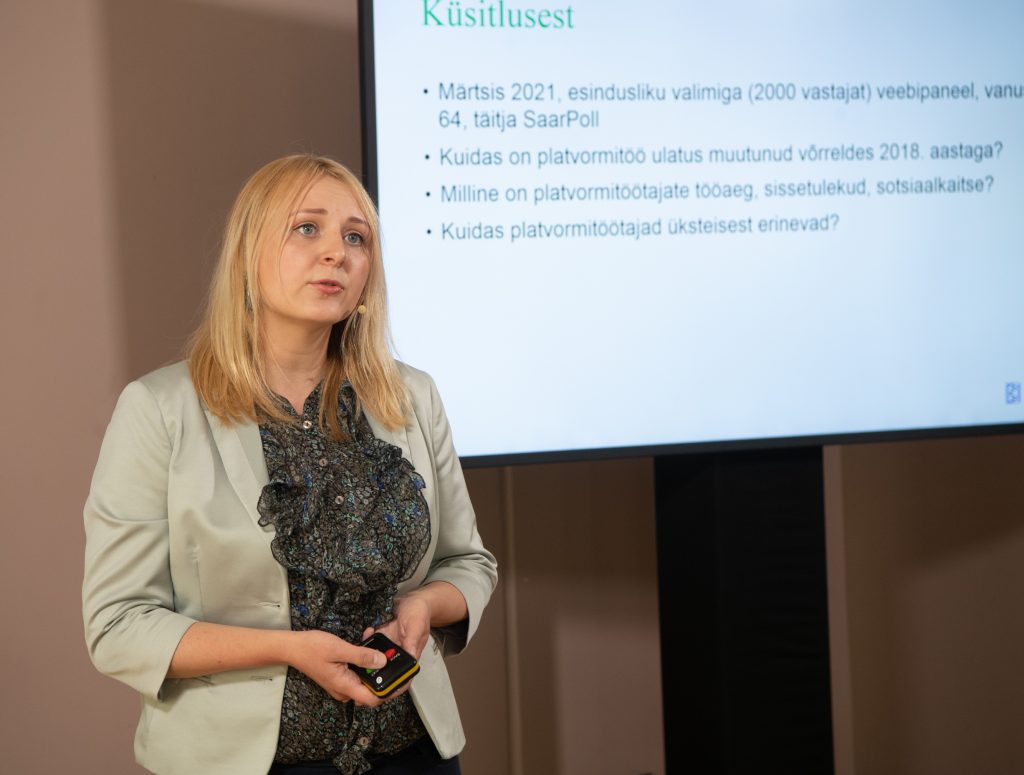The state has no overview of platform workers
The Foresight Centre study “Platform Work in Estonia in 2021” shows that the government lacks a detailed overview of platform workers and the extent of the tax gap relating to it. If the share of platform work grows even more in the future, an increasing part of such workers will remain without social protection.

“The government lacks a detailed overview of how many people work through digital platforms and how much they earn with that,” Expert of the Foresight Centre Johanna Vallistu said at the presentation of the study “Platform Work in Estonia 2021”. “At present, the platforms have no obligation to share any information on platform workers with the state.”
Vallistu thinks that although platform work gives the necessary flexibility to the labour market, the existing regulations leave the issues relating to social protection (e.g., health care, etc.) open. “Responsibility for organising their social protection is laid on platform workers themselves, but often they fail to do that,” Vallistu said. “Thus, in a longer perspective, the cheap platform work is paid for by the taxpayer, for example, when a person without social security insurance needs health care services.”
Vallistu pointed out that the share of platform work as a way of working was increasing, and if the issues relating to social protection were not solved, the problems would deepen. “Platform work offers the people of Estonia an excellent opportunity to participate in the global labour market, but in order to ensure the sustainability of the social security system, the regulations have to be adapted to changing forms of work.”
- Nearly 56,000 people, or 7% of the working-age population, work through digital platforms every week in Estonia. During the last year, more than 160,000 people have done platform work at least once, and on average, they earn nearly a fifth (18.4%) of their income from platform work.
- In comparison with the study conducted in 2018, the number of those who do platform work from time to time has increased. Nearly 100,000 people do it at least once a month.
- Platform work means doing gigs found through digital labour mediation platforms for different customers. Platform work may be both location-based and web-based and require little skill or specialised skills. The best-known types of platform work are ride-sharing, delivery services, as well as IT, work and graphic design on web platforms. The study conducted by the Foresight Centre deals with the eight most widely spread types of platform work.
Materials of the study (in Estonian)
- Study “Platform Work in Estonia 2021. Results of the survey”
- Brief report “Platform Work in Estonia 2021”
- Slides of the press presentation
Watch the presentation for the press in Estonian
In March 2021, the consultancy company SaarPoll conducted a study with a representative statistical sample on using platform work as a way of working in Estonia. The study was commissioned by the Foresight Centre within the framework of the study project “Future of Work”. See also the results of the 2018 study.
The Foresight Centre is a think tank at the Chancellery of the Riigikogu that analyses long-term developments in society and the economy. The Centre conducts research projects to analyse the long-term developments in Estonian society, and to identify new trends and development directions.
Latest news
-
10.11 2025Report: Estonia could learn how to control healthcare costs from the Netherlands
The expenses of the Estonian Health Insurance Fund significantly exceed its revenues, and the accumulated reserves will be depleted in the next five years. Other European countries in the same situation have cut healthcare services and increased people’s co-payments. According to the Foresight Centre’s new short report “Other countries’ experiences in managing healthcare budget deficits”, both solutions have worsened public health and deepened inequality.

 An independent think tank at the Riigikogu
An independent think tank at the Riigikogu